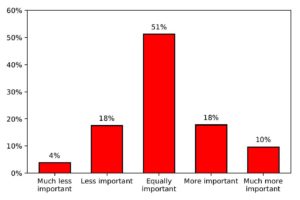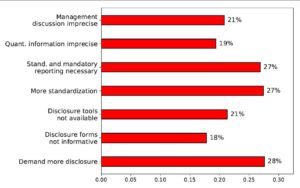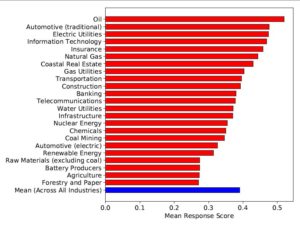Written by Emirhan Ilhan and Zacharias Sautner
Financial market efficiency relies on timely and accurate information regarding firms’ risk exposures. An increasingly important risk exposure relates to climate change. Climate risks can originate from more severe and more frequent natural disasters, government regulation to combat a rise in temperature, or climate-related innovations that disrupt existing business models (Litterman 2016; Krueger, Sautner, and Starks 2019). Consequently, high-quality information on firms’ climate risk exposures is necessary for making informed investment decisions and efficient pricing of the risks and opportunities related to climate change.
While many regulators and investors acknowledge the fact that firms’ climate risk exposures are important, they also believe current climate risk disclosure practices are insufficient. For example, Mark Carney, Governor of the Bank of England, called for more to be done “to develop consistent, comparable, reliable, and clear disclosure around the carbon intensity of different assets” (Carney 2015). In a similar spirit, Yngve Slyngstad, CEO of Norges Bank Investment Management, commented on the difficulty of obtaining climate risk-related data by saying that “the only surprise […] is how hard it is to get the data […] I think it will take years to get good data from the majority of companies we are invested in.” (Reuters 2018)
On a more positive note, there have been attempts by regulators, governments, and NGOs to address the shortcomings in current climate risk disclosures. For instance, in 2015, the Financial Stability Board initiated the Task Force on Climate-related Financial Disclosures (TCFD), with the objective of developing voluntary climate-related financial risk disclosures. On behalf of investors representing over $87 trillion in assets under management, CDP collects climate-related information through a questionnaire. In addition to these initiatives, some countries started to mandate climate-related disclosures. For instance, the U.K. requires quoted companies to disclose their carbon emissions (Krueger 2015; Jouvenot and Krueger 2019) since 2013, a requirement that has been extended to include unquoted companies from 2019 onwards. Since 2016, France requires institutional investors to report the carbon footprints of their investment portfolios.
While these initiatives suggest that investors increasingly require climate-related information for their decision making, little systematic evidence exists on how institutional investors think about such disclosures. To fill this gap in knowledge, in a new research paper with Emirhan Ilhan, Philipp Krueger, and Laura Starks, we surveyed institutional investors about their views and preferences with respect to climate-related disclosures. Since reporting on nonfinancial information can have benefits and costs (Christensen, Hail, and Leuz 2019), whether investors attribute value to climate risk disclosure by firms is both theoretically ambiguous and not directly observable. Thus, a survey allows us to understand better whether and how investors value climate risk disclosure.
We found that the survey respondents share a strong general belief that climate disclosure is important. As Figure 1 illustrates, 51% of respondents believe that climate risk reporting is as important as traditional financial reporting, and almost one-third considers it to be more important. Only 22% of respondents regard climate reporting as less (or much less) important compared to financial reporting.

Figure 1: Importance of climate risk disclosure relative to financial disclosure
We then examined whether systematic differences exist in perceptions of the relative importance of climate reporting across investors. We found that climate disclosure is perceived as more important among those investors who believe more strongly that it is important to consider climate risks in the investment process.
The risks climate change poses on firms are frequently divided in three distinct categories: physical risks, technological/transition risks, and regulatory risks. Our survey reveals that climate disclosure is deemed most important by those investors who worry strongly about the financial consequences (financial materiality) of each of these three risks for their portfolio firms. In terms of their relative importance, concerns about physical climate risks matter the most for the perceived importance of climate reporting, while regulatory risks matter the least. The strong role of physical risks in explaining the importance of climate disclosure may be because such risks tend to be more firm and location specific, requiring relatively precise information about a firm’s exposure to evaluate them. The investors would then have lesser ability to gather the information and greater need for firm disclosure. In contrast, regulations tend to apply the same way to all firms in a given industry and often even in a country. Therefore, information on such risks may be easier to obtain since firms in the same industry and country face similar regulatory risks.
In order to better understand investors’ views on the informativeness of climate risk disclosures, we asked the investors a series of questions on how they perceive current qualitative and quantitative disclosure practices. Qualitative disclosure can include narratives of how climate change affects business models or explanations of how climate risks are governed in firms. Quantitative disclosures may cover aspects such as information on the quantity of carbon emissions generated or on emission reduction targets. Figure 2 shows the responses to these questions. The figure displays the percentage of investors who “strongly agree” with the given statement on the current disclosure practice.

Figure 2: Institutional investors’ views on current climate risk disclosure practices
The responses demonstrate a widespread perception that current quantitative and qualitative disclosures are imprecise and insufficiently informative. Specifically, many respondents strongly agree that management discussions on climate risk as well as quantitative information on these risks are rather imprecise. These responses imply that the current voluntary reporting regime seems to not fully enable informed investment decisions by investors, at least for firms with large exposures to climate risks. This could be one reason why climate risks are considered difficult to price in equity markets, an issue we next address in more detail.
We first asked the investors how much mispricing they see in different sectors of the economy. The responses could range between “valuations are much too low” (coded with a score of -2) and “valuations are much too high” (coded as +2). We specifically asked about misvaluations related to climate risks and opportunities. Figure 3 shows that the respondents generally believe that current equity valuations are too high across all sectors of the economy, as reflected in the positive average response scores. Overvaluations are perceived as strongest in the sectors Oil, Traditional Automotive, Electric Utilities, and Insurance.

Figure 3: Institutional investors’ views on climate risk mispricing
We then studied whether the investors’ opinions on the availability and quality of current climate reporting are related to the perceived underpricing of climate risks in equity markets (i.e., climate-related overvaluation of firms). We found that respondents who believe that current reporting is lacking also perceive more mispricing in current equity valuations. An important consequence of this finding is that better disclosure may contribute to a more efficient pricing of climate risks. In fact, this implication is consistent with a view expressed by Michael R. Bloomberg, Chair of the TCFD, who stated that “increasing transparency makes markets more efficient, and economies more stable and resilient.”
Our analysis indicates that investors find climate risk reporting highly important for their investment decisions. However, current disclosure practices seem to be insufficient, both in terms of quality and quantity. Likely as a result of this, many investors perceive that equity valuations do not fully reflect the risks related to climate change. More and better reporting on climate risks may be helpful in improving the correct pricing of climate risks and may, as a result, preserve financial stability.
The research paper underlying this article is available here.